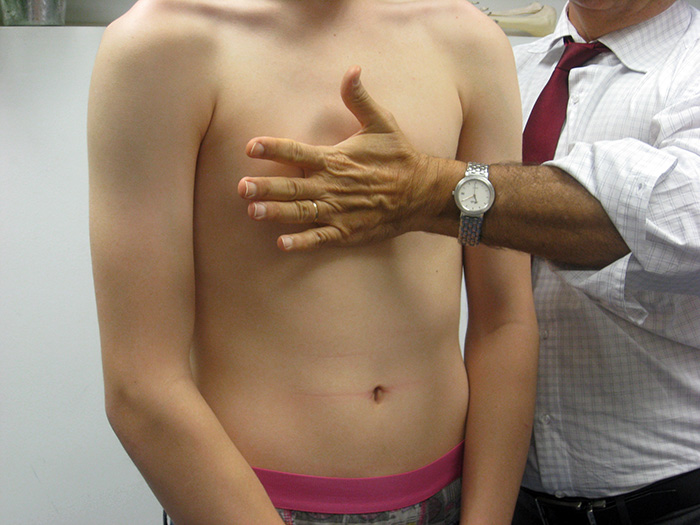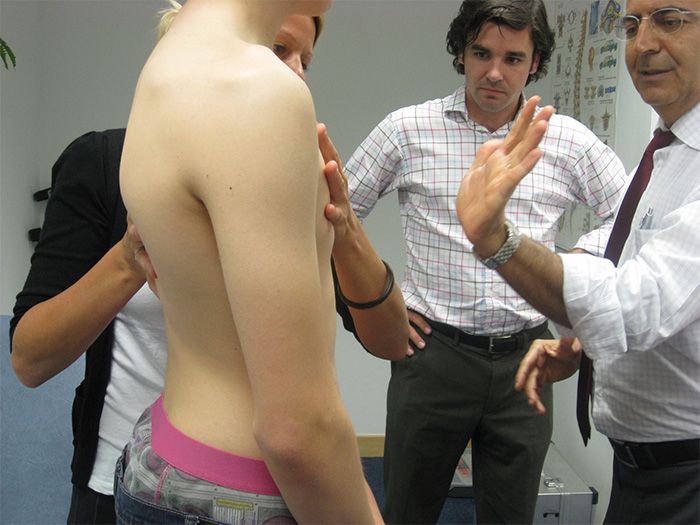Chest deformities like pectus excavatum and pectus carinatum are quite common in teenagers. Particularly in an age of social media and body shaming, the physical appearance of both conditions can be very challenging for some adolescents.
LOC clinicians are very much aware of this as we have discussed the psychological impact with parents and directly with patients. Patients are unwilling to take their t-shirts off, go swimming or put themselves in any position where they might reveal their chests.
Not surprisingly both parents and teenagers are looking for an answer. Surgery on the NHS used to be an option but even before the pandemic that option had become increasingly unavailable since the condition was deemed to be largely cosmetic and no risk to physical health.
LOC has been offering a non-surgical solution to the problem since 2010. Our treatment combines bespoke chest braces with a very specific set of exercises.

Pectus Excavatum, also known as 'funnel' or 'sunken' chest, is where the breast bone is pushed abnormally inward.
It is the most common form of congenital chest deformity which tends to become exaggerated during puberty where growth spurts cause the cartilage and bones to grow at a rapid rate.
For patients considering our non-surgical treatment for pectus excavatum, we offer the opportunity for an initial free consultation via Skype, Facetime or Zoom.

Pectus carinatum, also known as 'pigeon chest' is a congenital deformity of the anterior chest wall, and occurs when the breast bone (or sternum) is pushed outward by an abnormal overgrowth of cartilage.
Orthotic bracing is proven to be a safe and effective way to provide successful outcomes without surgical intervention.
For patients considering our non-surgical treatment for pectus carinatum, we offer a free online consultation with one of our pectus specialists.

LOC's pectus treatment is non-surgical and involves wearing a bespoke brace or orthosis called a 'Dynamic Chest Compressor', combined with a programme of Yoga exercises that have been developed specifically to augment our non-surgical treatment.
Most NHS trusts no longer recommend surgery for pectus carinatum and pectus carinatum as the conditions are considered to be cosmetic and no threat to physical health.
Our experience and development of custom-made braces has led to many patient success stories.

The Dynamic Chest Compressor is a chest brace used to non-surgically treat pectus carinatum and rib flaring. Also referred to as a pectus brace, it applies pressure over areas of the skeleton to remodel the chest and ribs.
Each pectus brace we make is entirely bespoke to each patient's specific chest shape and is designed to be worn throughout treatment.

Vacuum Bell Therapy is a non-surgical treatment option for pectus excavatum, a pectus deformity that causes the chest to appear sunken or caved in.
The manual pump sucks the air out of the device, creating a vacuum that pulls the depressed sternum and ribs outward. Over time, this pressure gently reshapes the chest and guides the sternum back to its normal position.

Rib flaring is where the ribs of the chest protrude outward, causing a noticeable bulge on the sides of the chest. The condition is common in pectus excavatum patients and can exacerbate chest deformity. Flared ribs can be treated with a bespoke rib flaring brace which moves the ribs back into a corrective position over time.

We offer free online pectus excavatum and pectus carinatum consultations via Skype, Facetime or Zoom for those worried about their chest shape.
Our treatment programme will be explained in detail so you can see whether treatment is right for you.

The London Orthotic Consultancy has been providing non-surgical pectus treatment since 2010 achieving positive results in our patients.
We are proud to be the pioneers of this treatment in the UK and are happy to share some patient successes for those who have undergone Pectus Carinatum treatment with us.

The London Orthotic Consultancy has been providing non-surgical pectus treatment since 2010 achieving positive results in our patients.
We are proud to be the pioneers of this treatment in the UK and are happy to share some patient successes for those who have undergone Pectus Excavatum treatment with us.

LOC director and pectus specialist, Sam Walmsley, has recorded a series of videos answering our client's frequently asked questions about our pectus treatments and exercise programmes.
For patients who want to avoid surgery, non-surgical pectus treatment can be a great way to achieve a flatter chest, but often, patients are unsure of what treatment involves.

We offer orthotic treatment for international patients seeking non-surgical pectus excavatum and pectus carinatum bracing in the UK. Our specialist clinicians have extensive experience treating pectus deformity patients from around the world.
We regularly treat international patients with our evidence-based orthotics including those from Europe, South America and the Middle East.

Information and price lists for our comprehensive pectus excavatum and pectus carinatum treatment packages, which include personal support throughout treatment, a bespoke exercise regime and physiotherapy support.
All fees associated with your treatment are included, such as appointments required for the duration of treatment.
There is no unified opinion on causation, but there is evidence to suggest that both pectus excavatum and pectus carinatum can be inherited conditions.
We are indebted to the late Dr Haje for the information that follows. Dr Haje was widely regarded as the world's leading authority on the non-surgical treatment of pectus deformities.
We have summarised his audit of the 4,346 patients he treated in the following page.

Above: Dr Haje training LOC staff in 2010
The London Orthotic Consultancy's pectus treatment is non-surgical and involves wearing a bespoke brace or orthosis called a 'Dynamic Chest Compressor', combined with a programme of daily exercises. LOC has pioneered this method of treatment in the UK.
Although the optimum age for non-surgical treatment is during puberty, the key determining factor is the pliability of the chest wall so older patients can also benefit if there is a ‘give’ in their chest wall.
For further information about our non-surgical treatment programme and the use of orthoses, read about our non-surgical pectus treatment.

Most NHS trusts no longer recommend surgery for pectus carinatum and pectus carinatum as the conditions are considered to be cosmetic and no threat to physical health. Privately the type of surgery performed in the UK is either the Nuss or Ravitch procedures. The Nuss procedure is minimally invasive compared to the Ravitch.
Good results have been reported from both types of surgery and patients are generally pleased with the improvement in chest shape. However, these procedures do not address the problem of rib flaring, which is fairly common, and patients can be left with visible surgical scarring.
Read more about treatment for pectus deformities.


“It’s life-changing, my swimming coach has even remarked what a difference my treatment has made" Read how pectus bracing treatment helped to correct Aris' complex chest deformity, involving a combination of pectus excavatum, pectus carinatum and rib flaring.

Cerebral palsy patient Lucas sees significant improvement in his walking after only six months in his new custom Ankle Foot Orthoses (AFOs), designed by Professor Saeed Forghany in our Manchester clinic. Hear how a detailed gait analysis and bespoke AFOs significantly improved Lucas's gait and comfort.

Freddie’s positional plagiocephaly was treated successfully with the LOCBand Lite, going from 11mm to 2mm after four months in his helmet.

Adult club foot (talipes) patient Natasha says, "I cannot stress how amazing my AFOs are and how they have changed so much for me. The support they give me allows me to walk without crutches outside the house for the first time in over fifteen years."

Diagnosed with adolescent idiopathic scoliosis at 14 years old, Polly and mum Zoe looked to the LOC Scoliosis Brace to help her curve and avoid surgery at a later date.

LOC opens its first clinic in Northern Ireland, LOC Belfast, offer non-surgical orthotic treatment for scoliosis, pectus carinatum and pectus excavatum. Here, we will also be able to provide orthotic treatments for a range of adult and paediatric lower limb conditions including cerebral palsy, spina bifida, hypermobility, stroke, post-polio syndrome, and multiple sclerosis.

Mum Natalie shares her experience of having both her identical twins diagnosed with craniosynostosis. Ella and Nina had surgery at Great Ormond Street Hospital before going through cranial remoulding therapy at the London Orthotic Consultancy.

See how a thorough gait analysis and a correctly-fitted, bespoke Reciprocating Gait Orthosis (RGO) helped Ted, a spinal surgery and cancer survivor, improve his rehabilitation and mobility goals, getting him back on his feet again.